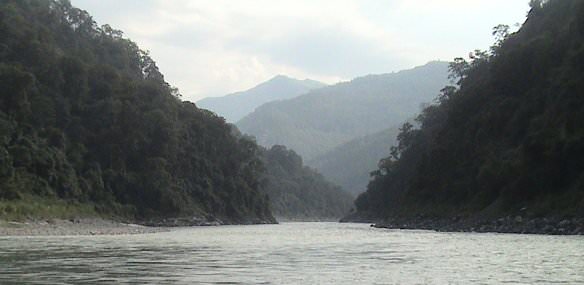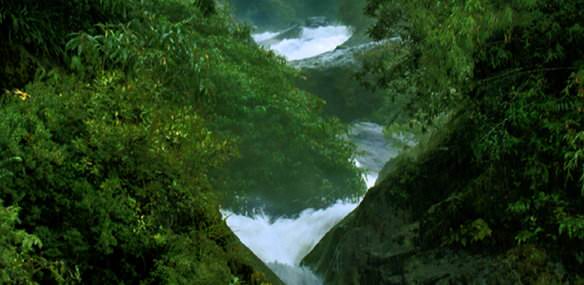

Affected Citizens of Teesta (ACT) - Teesta River
SIKKIM
Located on the flanks of the Eastern Himalayas, Sikkim was a hereditary monarchy till 1975, when it merged with India to become the 22nd state of the country.
The state shares its borders with Nepal in the West, Bhutan in the Southeast and China in the North. Sikkim is a land of dramatic contours with rugged mountains, deep valleys and dense forests consorting with glaciers, raging rivers and lakes and biodiversity hotspot. The state has the steepest rise to an altitude over the shortest distance and climate ranges from tropical to temperate to alpine. The variety in elevation gives Sikkim a rich botanical wealth. The world's highest National Park (Khangchendzonga National Park) is located in this region. There are over 4000 species of plants and luxuriant forests which cover 36 per cent of the land. These dense forests are the habitat for a variety of animals, some of which are today threatened with extinction because of changes in the eco-system.
Sikkim has three main ethnic groups, the Lepchas, the Bhutias and the Nepalese. The total population is 540 851 persons with 288 484 male and 252 367 females. The Nepali community consists of diverse ethnic groups and forms the largest percentage of the population. The Bhutias including similar communities are around 70 308.
The Lepchas who call themselves the Mutanchi Rongkup, are Sikkim's earliest inhabitants and around 40 568 in Number (2001 census). The Majority of the Lepchas live in "Dzongu" which is considered the Cradle of Lepcha civilization. It is a region protected by various traditional and enacted laws to safeguard the indigenous aborigines from exploitation and other hazards. The culture, customs and traditions of the Lepchas are inextricably linked to their deep bond with nature, but changing times and modern developments have started disturbing the delicate eco-system with which they have lived so closely over centuries.
Apart from these there are many "plainsmen" from different parts of the country settled here as well as a small community of Tibetan exiles. Lately the state has witnessed a large infusion of migrant laborers, brought here to work on large hydroelectric power projects like the Rangit and Teesta HEP Stage V as well as the continued import of people by the Border Roads Organization.The total land mass comprises of 7096 sq kms and lies within 27° - 28° latitude and 88° - 89° longitude. The crowning glory of Sikkim is Mt. Khangchendzonga, the third highest mountain in the whole world. For the Sikkimese, Khangchendzonga is much more than a mountain and is revered as the abode of their guardian deity Dzo-nga. The Zemu Glacier is the source of mighty river Teesta, which originates in the tundra like region at 18000 ft and flows down to the Bay of Bengal crisscrossing through different places in Sikkim and West Bengal. The Rangit River originates from the Rathong Glaciers. The water for these rivers is fed by the melting snows and the rain in the catchment areas.
Rivers are an integral part of the Sikkimese ethos. Much of the folklores and traditional ways of life of the locals revolve around the mighty Teesta and the Rangeet Rivers. The River Teesta not only sustains the livelihood of the locals, by preserving and propagating the rich biodiversity which includes the cultivation of the state-wide main cash crop, the Cardamom, but is also the very backbone of Sikkim's cultural heritage.
SIGNIFICANCE OF TEESTA (RONGNUE) AND RANGEET
The Lepcha call themselves "Mutanchi Rong" meaning the beloved children of God. Their original ancestors, "Fodong-Thing" and "Nazong-Nyu", the first man and woman were created by Almighty God "It-Bu-Rum" from the eternal purity and the holy snows of the Kongchen-Chu, meaning Mt. Khanchendzonga. As such, even to this day, the Lepchas worship Khanchendzonga as their Guardian deity.
The story is woven around two lovers - Rangeet and Rongnue. Rangeet symbolizes river Rangeet and Rongnue symbolizes river Teesta, popular rivers of Sikkim. They used to meet in a place secretly. When their love was known to all, they offered salutations to the Kanchen-Chu (Mt. Khanchendzonga) and decided to go down to the plains.
Rangeet was led by a bird called Tut-Fo (Partridge) and Rongnue by Paril-Bu (King Serpent) who served as their guides and agreed to take them to Pozok, now known as Pesok, their promised trysting land or confluence through slopes of Himalayas meandering through the lovely valleys, thick forests and steep hills. From there they would travel together to the plains to the land of the unknown.
Rangeet"s guide being a bird traveled through circuitous routes in search of food and thereby led him through many zig zags and thus reached very late for their appointed tryst at Pesok.
As Rongnue was guided by a serpent, she was led in serpentine way searching their destination long before their appointed time. There Rongnue waited patiently for the lover Rangeet who had not arrived yet.
When Rangeet reached the promised place, Pozok, he was surprised to see his darling Rongnue had arrived there much before him. In surprise he uttered the words "Thistha", Rangeet was very much ashamed, vexed and also disappointed as being a male he should have arrived first and then waited for his darling Rongnue to take her down to the plains, the land of the unknown. But instead his darling had arrived first, so he decided to go back to the Himalayas, the land of his origin. At this time a very great flood occurred and marooned all the people and living creatures. The people and the creatures all fled to the high hills and mountains and even then the flood rose and lapped them.
The flood waters went on rising up and even threatened to reach the top of the mountain, "Tungrong" (Mt.Tendong), even then to the surprise of all, the presiding deity in the form of a bird - Kohok Fo - appeared on the top of Tungrong and prayed for subsiding the water by sprinkling Chi. Miraculously the flood subsided saving the remaining Lepchas and other creatures.
On the other hand, Rongnue lovingly wooed his lover Rangeet not to be vexed. She explained to him that he had been brought late to the trysting place due to the fault of the guide, therefore it was no fault of theirs.
Thus Rongnue agreed to flow and Rangeet. Both of them decided to go down together to the plains from Pesok.
As such to this day in Lepcha marriage the tale of river Rangeet and river Rongnue is sung and danced by the Lepchas. The bride and the bride groom are always taken as the river Rongnue and Rangeet. The Lepchas wish the newly wedded couple a happy and prosperous life in future like the river Rangeet and the river Rongnue.

TEESTA UNDER THREAT
River Teesta has glacial origins. The glaciers in Sikkim are located in the northern and northwestern part of the Sikkim Himalaya. Apart from providing scenic beauty they are the water tower in the region and the controller of the hydrology and geo-hydrology and hence the water ecosystem in the region. They are the sources of all the perennial rivers and streams. Observations, by the geo-scientists, of the Himalaya have led to the detection of various rates of glacial retreat in different parts of the Himalaya. In this connection it is observed that the Zemu Glacier of North Sikkim has been retreating 8 meters per year while the Kangchenjhau Glacier in North Sikkim is behaving differently from those of the adjoining areas in recent times. The retreating glaciers are altering the hydrological regime in the Himalayan region and also pose environmental risks such as Glacial Lake Outburst Floods (GLOFs) and increased sedimentation. Therefore information on the glaciers and impact of climate change on them are critical to gauge the long term viability of dams in the Himalayan region.

| SATYAGRAHA |
Warriors for a Cause
"I will die but won't allow the mega power projects in Dzongu" - Dawa Lepcha.
Two Lepcha youths from Dzongu rocked the state of Sikkim and the world with their selfless stand against the hydro projects. Dawa T. Lepcha and Tenzing Lepcha went on hunger strike in the spirit of Gandhian Satyagraha from June 22, 2007 to September 27, 2009.
Chronicles of the campaign - and more - at
| TEESTA |
Will the Teesta river survive? In order to construct one kilometer of tunnel, approximately 150 tons of dynamite are required. Imagine how much blasting will be done for 30 power projects! Seventy percent of the river to flow underground!
| DZONGU |
Dzongu in North Sikkim is the holy place for Lepchas spread all over the world. Process has begun for seven mega power projects spanning the length and breadth of this protected area.
| ENVIRONMENT |
Environment Impact Assessment (EIA)
Blatant violations of procedural and environmental norms. Get the distressing facts at our EIA-page.
| TEESTA STAGE V |
Much went wrong during design, assessment and construction of Teesta Stage V HEP. For a truly sustainable and adapted development, a different approach is required.
| VIOLATIONS |
Environment Protection Act (EPA) as well as Forest Conservation Act (FCA) were repeatedly violated by the companies involved. A non-exhaustive listing for Teesta Stage V only (NHPC).
| DOCUMENTS |
• Statements, appeals and proceedings by ACT
• Scientific papers substantiating ACT's concerns
• Press reports covering disproportionate projects in Sikkim and ACT's struggle for protection
| MEDIA |
• Photo-Galleries
• Collection of Documentaries
© Affected Citizens of Teesta 2007 - 2023
NGOs supporting ACT: Concerned Lepchas of Sikkim (CLOS) - Sangha of Dzongu (SOD) - Citizens Forum of Sikkim (CFS) - Sikkimese Association for Environment
While all the organizations supporting ACT share the common goal of protecting the environment, individual groups can, and sometimes do, differ in their approaches to specific issues highlighted above. The stand taken by ACT does not necessarily includes of everybody in Sikkim and other parts. If anyone wishes to differ, they are welcomed to put forward their views, comments and disagreements to info@actsikkim.com. Everybody is welcome!